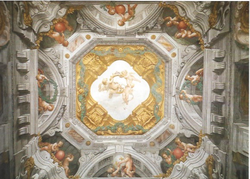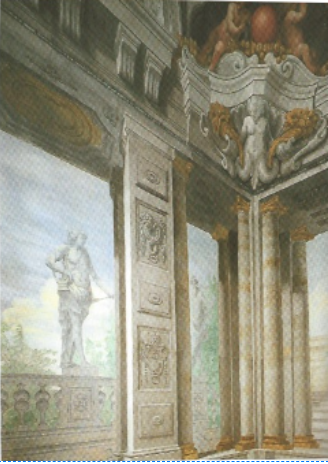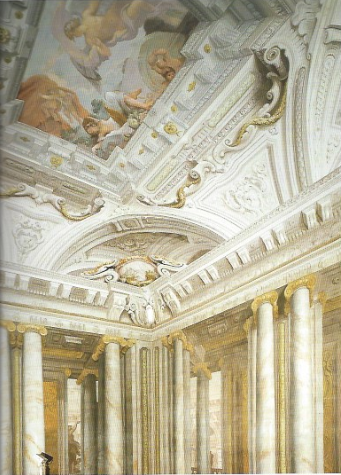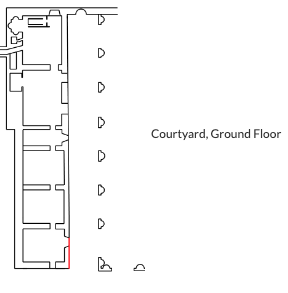Jacopo Chiavistelli
1621-1698
The Florentine Jacopo Chiavistelli (1621-1698) worked intensely and continuously for the Medici, beginning in 1661, particularly at Palazzo Pitti, beginning with the decoration of the “summer” apartment on the ground floor of the wing to the right of the courtyard, where he created a vast suite of rooms for Cosimo, the heir apparent (later Cosimo III) and his wife of that year, Margherita Louisa d’Orleans, the niece of Louis XIV. This large apartment, consisting of eight rooms and a salone, was completely decorated with frescoes and fake architectural elements that covered the walls and ceiling in much the same way as Mitelli and Colonna had decorated the “summer” apartment for Ferdinando II. Assisting in the enterprise were Francesco Bettini (who later was involve in the decoration of the Gran Principe’s alcove on the piano nobile), Cosimo Ulivelli for the figures, and Agnolo Gori for the garlands and fruit. Of this enormous decorative project, only the frescoes of two rooms are conserved in a decent state. What remains in the other rooms are only pale fragments, making it difficult to distinguish which frescoes are the work of the two “figuristi”, even if we hypothesize the intervention of the first in the background of the ceiling with the figure of Juno. The large salone, which was largely destroyed in the 19th Century when the area was transformed into the Cappella Palatina, is described with great precision b Bocchi-Cinelli, who records that the complex architectural score of the walls opened onto a false loggia, through which we could see “fabbriche nobili”, while the ceiling, open with false architectural elements of white and gold stucco, surrounded three panels, one with the arms of the prince and the others with representations of Diana and Apollo in chariots. Quite possibly here we would have found the work of both “figuristi” in the details of the complex decoration, even if the biography of the artist published by Leoncini (1984) says that Chiavistelli wanted to demonstrate his capacities without the help of Ulivelli in this area.
The success of this project won for the artists other decorative projects in the palace (but the frescoes made for Giovan Carlo and for Leopoldo, [Goldberg 1988, page 10, note 46] have disappeared). Most prominently among this additional work is the decoration of the “summer” apartments of the grand duchess mother, Vittoria della Rovere in 1671, adjoining those of her husband, Ferdinando II. These decorations were partially destroyed during the construction of Poccianti’s staircase and the entrance for carriages in this wing in the 19th Century. What survives is the beautiful decoration of the bedroom, formerly belonging to Maria Maddelena of Austria, with the Allegory of the Dream in the background. Here, the walls, covered in a thick arrangement of columns that open onto a loggia and through which we can see architectural elements, are surmounted by a powerful cornice on which is perched the fake architecture of the ceiling vaults..
It is probable that the Cortonesque Allegory of the Dream is the work of Chiavistelli, as are the figures in the rest of the apartment.
Marco Chiarini; “The Activities of Jacopo Chiavistelli at Palazzo Pitti”; Palazzo Pitti: l’arte e la storia; Firenze; 2000-2003, pp. 143 - 145 .
The success of this project won for the artists other decorative projects in the palace (but the frescoes made for Giovan Carlo and for Leopoldo, [Goldberg 1988, page 10, note 46] have disappeared). Most prominently among this additional work is the decoration of the “summer” apartments of the grand duchess mother, Vittoria della Rovere in 1671, adjoining those of her husband, Ferdinando II. These decorations were partially destroyed during the construction of Poccianti’s staircase and the entrance for carriages in this wing in the 19th Century. What survives is the beautiful decoration of the bedroom, formerly belonging to Maria Maddelena of Austria, with the Allegory of the Dream in the background. Here, the walls, covered in a thick arrangement of columns that open onto a loggia and through which we can see architectural elements, are surmounted by a powerful cornice on which is perched the fake architecture of the ceiling vaults..
It is probable that the Cortonesque Allegory of the Dream is the work of Chiavistelli, as are the figures in the rest of the apartment.
Marco Chiarini; “The Activities of Jacopo Chiavistelli at Palazzo Pitti”; Palazzo Pitti: l’arte e la storia; Firenze; 2000-2003, pp. 143 - 145 .

The decoration of this room, well-conserved, documents Chiavistelli's ability to organize finite spaces in areas that are not large, as in this case: his personal interpretation of the method of "quadratura".
|
For all the Florentines, the use of elements with their origins in the late renaissance, like the pediments that dominate the doors and the airy perspective behind the pillars, makes the space open onto a garden, populated with statues. In this decoration, where the artist studied several drawings, we can also see the collaboration of Agnolo Gori in the garlands that crown some architectural elements. |


